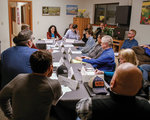
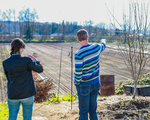

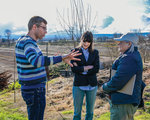

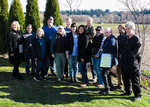

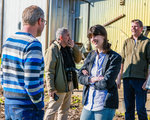

Clark County’s new representative in Congress visited Woodland last week alongside a key figure involved with federal agriculture policy to discuss issues local farmers face in the shifting industry.
U.S. Rep. Marie Gluesenkamp Perez, D-Skamania, met with farmers from Clark and Cowlitz counties during a roundtable discussion at Our American Roots, a wholesale flower seller located between La Center and Woodland.
Gluesenkamp Perez was joined by U.S. Under Secretary of Agriculture for Rural Development Xochitl Torres Small as they learned about the struggles and success farmers have experienced.
“If we’re not supporting farmers, we’re not supporting our long-term security … we’re not supporting the health of our country, and we’re not supporting economic vitality,” Torres Small said.
The roundtable attendees included Ruud van der Salm, the general manager of Our American Roots, which deals in wholesale plants, to Gather and Feast Farm, a 20-acre operation known for its striking Scottish Highland cows.
Changing land use
Ed Hamilton Rosales, manager of the Western Institute for Agriculture and Food Security, said Southwest Washington lacks the structure needed to allow new agricultural markets to change with the times.
“There is no food hub, per se, to bring your produce to,” Hamilton Rosales said.
Joe Zimmerman, finance and marketing director for Brush Prairie-based Bi-Zi Farms, mentioned the farm’s location on Northeast 119th Street allows the business to distribute its products from its property.
“The only saving grace is if your great-great-grandparents happened to purchase land on what would 100 years later become one of the busiest routes through Clark County,” Zimmerman said.
The farm has been in existence for more than 150 years and switched gears from a commodity grain farm in the 1990s to a direct-to-market farm, Zimmerman said.
Zimmerman’s father and Bi-Zi Farms patriarch, Bill, said the switch wasn’t easy. The farm had to start up its direct sales under the nose of its loan lender until they got established, because at the time, the lender wouldn’t allow that business structure.
The younger Zimmerman said land use planning from decades ago that broke farmland into smaller parcels made it unrealistic for would-be farmers to have enough land for a sustainable operation.
Clark County Councilor Sue Marshall is involved in agriculture as she grows mainly hazelnuts at Baurs Corner Farm with her husband.
Marshall said Oregon adopted growth management laws 20 years before Washington. As a result, a lot of the development moved across the Columbia River.
When Washington adopted the Growth Management Act, property owners were told their land use would be restricted and were encouraged to break up their parcels, she said.
“I think that there are strategies to begin to aggregate, (but they) are going to be difficult,” Marshall said.
At the local level, Marshall said the update to the county’s comprehensive growth management plan will be pivotal for the future of agriculture.
“I think we’re at the point where we really have to make decisions of whether or not we have agricultural land going forward,” Marshall said.
Shifting pressures
Erin Thoeny, of Thoeny Farms, said she is one of a few who have experience selling to chain stores, farmers markets, commodity contracts and direct sales. Her family farm used to grow mainly carrots before they moved to strawberries, then raspberries, and through a number of other crops, as they adapted to changing market forces.
Ironically, many types of “farmers markets” haven’t been a successful option for larger-scale agriculturalists, Thoeny said.
“They’ve become entertainment zones rather than for sale for farmers,” she said.
Thoeny said the public conception of farming doesn’t always match up with the reality of the industry.
“People forget that farming is not a Pinterest photo,” she said. “Farming is a business first and foremost.”
She also mentioned not every farmer can have the success of places like Bi-Zi Farms.
“Not everybody is designed to sell direct to market,” Thoeny said.
Compounding that problem is a lack of processors in the region who act as a middleman between the growers and retail.
Torres Small said there are a number of opportunities for support through the USDA, like the value-added producer grant.
Thoeny cautioned that the bulk of the money in the grants she has seen goes to consultants. She said value-added agriculture has its own constraints and requires working successfully with local governments in areas like public health and zoning.
“There’s some disconnects there, and it gets into the weeds and at that point, things fall apart,” Thoeny said about working through government bureaucracy.
Federal officials’ reactions
Though the challenges Clark County has in agriculture are shared across the county, Torres Small said the local community’s efforts to preserve the industry stands out.
“It was neat to see the ways farmers are working together on that issue and the way people are stepping up into elected office,” Torres Small said.
Prior to their stop at Our American Roots, Gluesenkamp Perez and Torres Small visited the Port of Kalama to talk about rural broadband efforts. Last year, the ports of Ridgefield and Woodland received a $50,000 grant for a feasibility study on a broadband loop that goes across the northeast part of Clark County and along the Lewis River in Cowlitz County.
Gluesenkamp Perez related the ports’ collaboration on broadband with their historical place in other industries like timber.
“The natural chokepoints necessitated collaboration that is durable and I think makes Southwest Washington really special,” Gluesenkamp Perez said.
On the agricultural front, Torres Small said what she saw locally in Southwest Washington fits well with U.S. Secretary of Agriculture Tom Vilsack’s goals for the nation’s agricultural vision.
“What I got to see here is the way folks were finding alternatives, were diversifying their crops, were going from one crop to the next to continue to keep their businesses alive,” Torres Small said.
Seeing how local farmers have handled industry changes makes it easier for the USDA to develop ways to support those farmers, Torres Small said.